Payment Fraud Statistics 2024
Payment fraud data is reported by payment service providers (PSPs) including banks, credit unions, payment institutions, e-money institutions and payment service operators (companies that processes clearing and settlement of payment transactions) resident in Ireland in accordance with the Payment Statistics Regulation introduced in 2022.
Total Value of Fraudulent Payments in Ireland Increased to €160 million in 2024
- During 2024, €160 million in fraudulent payments were recorded by Irish resident Payment Service Providers (PSPs), representing a 24.5 per cent increase from €129 million in 2023. The total volume of fraudulent payments also experienced a significant rise, increasing by 40.7 per cent from 579K in 2023 to 815K in 2024. The growth is predominantly driven by fraudulent e-money transactions and money remittances[1] by both value and volume of payments. (Chart 1)
Chart 1: Total Value and Volume (number) of Fraudulent Payment Transactions (sent)
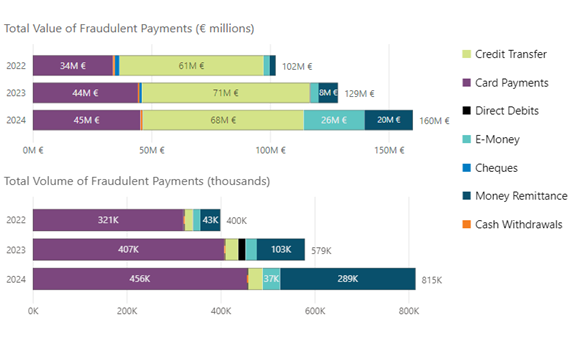
- The value of fraudulent e-money payments increased significantly to €25.6 million in 2024 from €3.3 million in 2023. Similarly, fraudulent money remittances more than doubled from €8.2 million in 2023 to €20.4 million in 2024. Card payment fraud increased slightly by 2.5 per cent amounting to €45 million while credit transfers declined by 4.3 per cent from €70.7 million to €67.7 million in 2024.
- Direct debits and cheques showed a considerable decline in the value of fraudulent payments in 2024. This amounts to €9.5 k from €356.8K in 2023 for direct debits and €178.7K from €1 million in 2023 for cheques.
- Online payments accounted for 77.4 per cent of the total fraudulent value in 2024 amounting to €124 million. This represents a 22.9 per cent increase from €100.9 million in 2023. For the most commonly used payment methods like credit transfer and card payments over 86 per cent of the fraudulent payments by value were initiated online in 2024.
Fraud Rates and Average Value of Fraud
- The fraud rate[2] in Ireland, as a total of all payment methods, remains low and stable. By value, the rate is 0.001 per cent, and by volume, the rate is 0.01 per cent. For volume, this corresponds to 1 in 10,000 payment transactions impacted by fraud.
- The rate of fraud varies depending on the type of payment used. The fraud rate for credit transfers remained constant at 0.001 per cent, aligning with the overall fraud rate for the period 2022-2024.
- Money remittances have shown the highest fraud rate among all payment methods, peaking at 0.081 per cent in 2024. While this marks a steady increase from 0.018 per cent since 2022, the average value of these fraudulent payments decreased in 2024.
- Card payments and e-money payments each had similar fraud rates at 0.029 per cent by value in 2024. This was a considerable rise from 0.006 per cent in 2023 for e-money and a slight decline from 0.035 per cent in 2023 for card payments. Direct debits have shown the lowest fraud rate of all payment methods, with a negligible rate of 0.000 per cent.
Chart 2: Average Fraud Value and Fraud Rate (%) by Payment Method
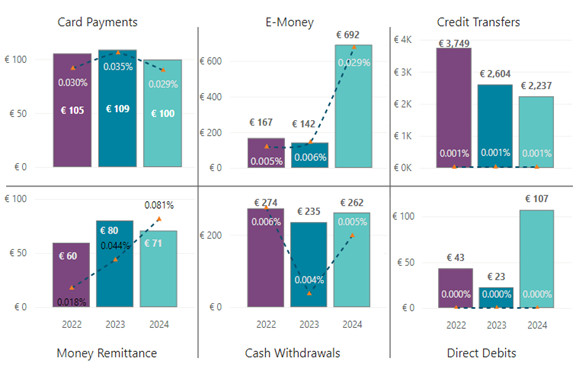
- The average value[3] of fraudulent payments also varies according to the payment methods used. For credit transfers the average value of fraud fell from €3,749 in 2022 to €2,237 in 2024 and remains the highest of all payment methods.
- E-money had the second highest average value of fraud at €692 in 2024, a notable spike from €142 in 2023. Direct debits also saw an increase, reaching €107 in 2024 from €23 in 2023
- Card payment fraud averaged €100 while cash withdrawal fraud using cards averaged €262 in 2024.
- Despite the higher fraud rate and the increase in the value and volume of fraudulent payments, the average value of fraud in money remittances was the lowest among all payment methods in 2024 at €71
Main Types of Fraud
- Payment frauds are broadly classified into four main types under the payments regulation, and the data is available for all electronically initiated payment types[4].
- ‘Issuance of payment order by the fraudster’ [5] is the dominant fraud type across all payment methods but on a declining trend in the last two years. In 2024, this represents nearly 88 per cent of the card payments fraud, 92 per cent of the cash withdrawal fraud and 42 per cent of e-money fraud (Chart 3). Within this category, ‘Card details theft ‘[6] constitutes more than half of all issuance of payment order card fraud, representing 68 per cent in 2024. Similarly, in cash withdrawals, 85 per cent of such fraud is due to its sub-category ‘Lost or stolen card’ (Chart3a).
Chart 3: Shares of Main Fraud Types by Payment Value
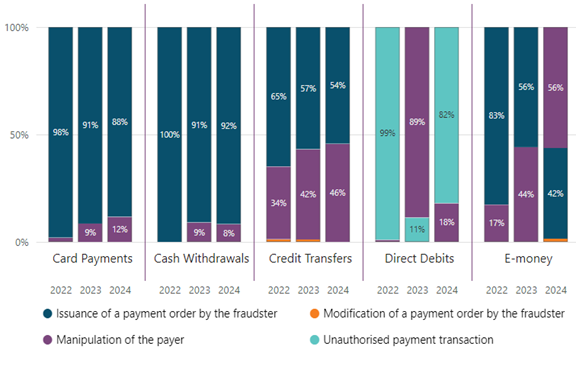
Chart 3a: Shares of Sub Categories in ‘Issuance of Payment order by the fraudsters’ by Payment Value
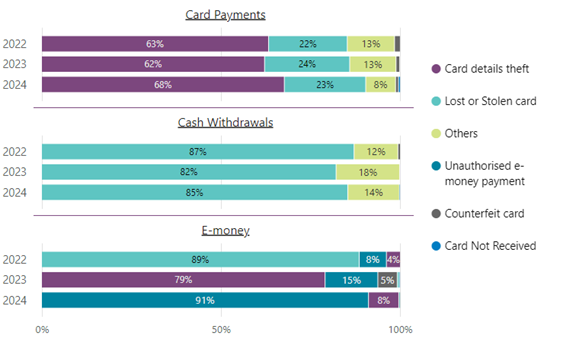
- ‘Manipulation of Payer Fraud’ [7] has shown a consistent upward trend in credit transfers and e-money payments. For credit transfers such fraud has grown from 34 per cent in 2022 to 46 per cent in 2024. Similarly, in e-money payments from 17 per cent in 2022 to 56 per cent in 2024 indicating a shift in fraud methods (Chart 3).
- ‘Unauthorised payment transaction’[8] is evident in direct debits, constituting 82 per cent of its total fraud in 2024. This represents a re-bound from 11 per cent in 2023 due to a one-off incident recorded in a different category. ‘Modification of payment order by fraudster'[9] is a relatively minor fraud type accounting for less than 2 per cent reported under e-money transfers for the first time.
Cross-Border Fraud Dominates the Geographical Aspect of Fraud and Corresponding Fraud Rates
- The Geographical dimensions of fraud are defined by the location of the account to which a fraudulent payment is sent. Overall, cross-border payments dominate fraud trends across all payment types except cheques and cash withdrawals. (Chart4)
- Fraud relating to ‘Cross-border payments within the EEA’ [10] is mostly seen in credit transfers and direct debits. The share of fraudulent payments for credit transfers in this category rose from 17 per cent in 2022 to 41 per cent in 2024. For direct debits, the share fell from 87 per cent in 2022 to 75 per cent in 2024 but still remains dominant. Despite this movement, the fraud rate by value remained low and steady at 0.001 per cent for credit transfers and at 0.0001 per cent for direct debits in 2024.
- Money remittances and card payments have shown a higher share of fraud in ‘Cross border transactions outside the EEA’. Over 80 per cent of the fraud in money remittances relates to such fraud across the years analysed. While for card payments this accounted for 42 per cent in 2022, 35 per cent in 2023 and rebounded to 41 per cent in 2024. Both card payments and money remittances exhibited a higher fraud rate of 0.1 per cent and 0.08 per cent respectively in this sub-category in 2024.
Chart 4: Shares of Geographic Dimensions of Fraud by Payment Value
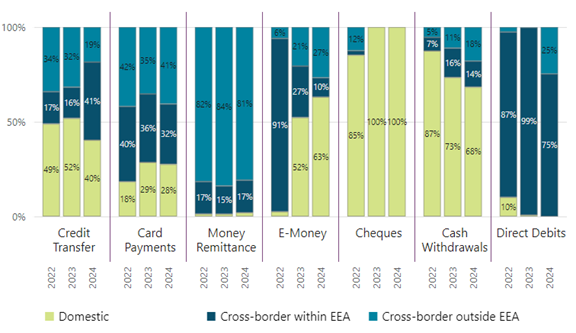
- For fraud concentrated in domestic transactions, the most affected payment types are cheques, cash withdrawals and e-money. The Fraud in e-money payments have shifted towards domestic from only 3 per cent in 2022 to 63 per cent in 2024.This is also reflected with a higher fraud rate of 0.2 per cent by the value of e-money payments. In contrast the total value of domestic e-money payments has shown a decreasing trend in 2023 and 2024.
- Fraud rates for cash-withdrawals and cheques in domestic payments remained low at 0.004 per cent and 0.002 per cent.
Peer-to-Peer Mobile Payments by Value Exhibit Higher Levels of Fraud
- ‘Mobile payment solution’ is a broad term for using a mobile device (like a smart phone or tablet) to initiate, authorise or complete a payment. This category includes P2P (Peer-to-Peer) payments which facilitates direct person to person transactions via digital wallets and mobile apps. Credit transfers, card payments, and e-money transactions can be initiated using P2P mobile payment solutions.
- In 2024, a total of €52.4 billion payments were processed using Mobile payment solution of which, 46 per cent (€24 billion) involved P2P payments. This resulted in a total of €6.7 million in P2P payment fraud, and the value has more than doubled from €3.2 million in 2023.
Chart 5: P2P Mobile Payment Fraud and Fraud Rate (%)
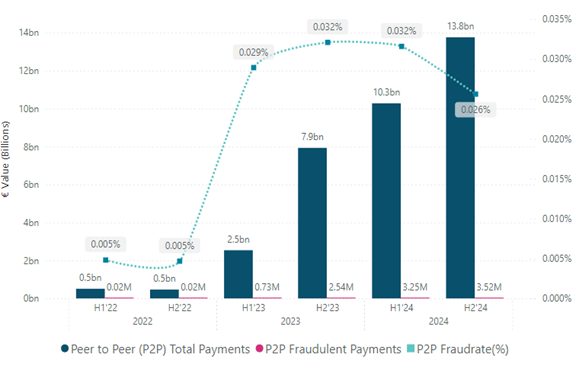
- The fraud rate by the value of P2P payments also shown a significant rise from the first half of 2023 (Chart 5). It started at a lower rate of 0.005 per cent in 2022 and peaked at 0.03 per cent in the first half of 2024. In terms of the volume, fraud rate remained stable and low at 0.01 per cent across reference periods even as P2P card payments maintained a higher rate at 0.1 per cent in 2023 and 2024.
Fraudulent Payments Continue to Rise despite Using Strong Customer Authentication (SCA)
- Strong Customer Authentication (SCA) is a requirement under PSD2 to enhance the security of electronic payments and reduce fraud. It mandates the use of two-factor authentication to verify a customer’s identity during a payment. This applies to electronically initiated credit transfers, card payments, and e-money payments.
- The total value of fraudulent electronic payments increased by 22 per cent in 2024 to €127 million, up from €103 million in 2023. Of this total, 63 per cent or €79 million was authenticated using Strong Customer Authentication (SCA) in 2024. This represents a significant increase in the share of SCA from 50 per cent (€50.9 million) in 2023 (Chart 6 R.H.S).
- Fraudulent credit transfers using SCA increased to 62 per cent of the total in 2024 from 53 per cent in 2023. E-money payments subjected to fraud exhibited the highest proportion of SCA usage at 92 per cent of their total value in 2024 amounting to €23.6 million. In contrast, the share of SCA authenticated fraudulent card payments decreased marginally by 1 per cent and stood at 45 per cent in 2024 (Chart 6 L.H.S).
Chart 6: Share of Fraudulent Electronic Payments (in value) by the Use of Strong Customer Authentication(SCA)
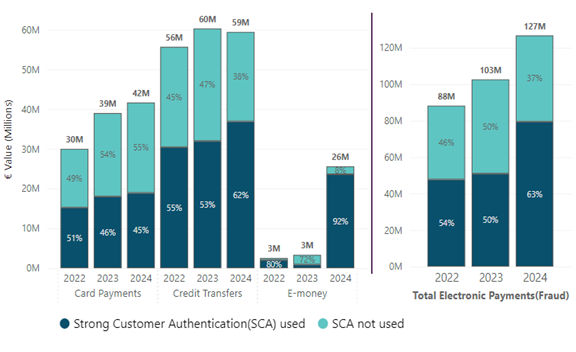
- The volume of fraudulent electronic payments increased by 15 per cent from 441K in 2023 to 509k in 2024. Despite this growth, the share of payments authenticated with SCA by volume remained relatively low and stable across all payment methods representing approximately 24 per cent of the total volume in 2024, 21 per cent and 26 per cent in 2023 and 2022. This trend is mainly driven by card and e-money transaction volumes, with less than one-fourth of these payments being authorised using SCA.
Fraud Loss by Liability Bearer in 2024
- Total losses [11]due to payment fraud totalled €66.4 million in 2024, an increase of €2 million from €64.4 million in 2023. These losses cover the cost of fraudulent payment activity across payment instruments, including credit transfers, direct debits, card payments, cash withdrawals and e-money payments.
- The largest proportion of fraud losses consistently came from credit transfers which showed a significant increase from €25.6 million in 2022 to €44.8 million in 2023 with a slight decline to €39.6 million in 2024.
- Additionally, e-money payments showed an exceptional spike in losses, rising sharply from a low base of €0.7 million in 2022, to €12.4 million in 2024
Chart 7: Fraud Losses by Liability Bearer and Payment Method
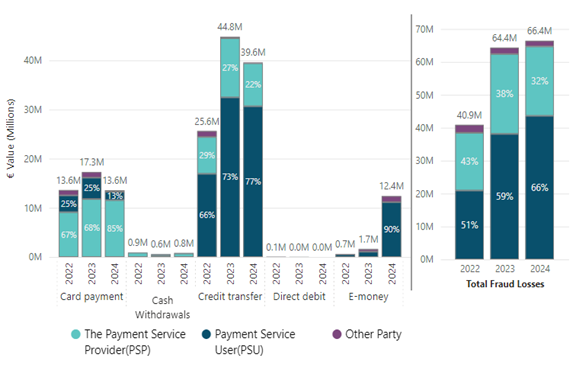
- In 2024, 66 per cent of the total fraud losses were borne by the Payment Service User (PSU)[12]. This trend associates to the use of strong customer authentication as around 63 per cent of fraudulent electronic payments by value in 2024 are authorised by the payer. In such cases, the PSP’s are not held liable to refund the money under the prevailing PSD2 framework. However, the EBA has identified this as an area for improvement. A legal opinion is currently underway with proposals for PSD3/PSR to amend liability rules for authorised payments particularly when a PSP fails to implement effective fraud detection and preventive measures
- For card payments, the majority of the losses are borne by the Payment Service Provider (PSP) accounting for 85 per cent of the losses totalling to €11.6 million in 2024.
Explanatory notes
The data collection is a semi-annual basis and fraudulent payments reported are subject to revisions if the fraud is not reported within the reference period.
The Central Bank has a consumer explainer available titled Can you spot a Scam Artist
-----------------------------------------------------
- Money remittances are widely used in bill payments where cash is involved in one or either side of the payment. But it’s not limited to cash. Cashless funding of remittance transactions is also possible and is therefore included in the reporting. The defining feature of a remittance is the fact that funds are received from a payer without any payment accounts being created in the name of the payer or payee. ↑
- Fraud rate is the share of fraud to total value of payments ↑
- Average value of fraud is total value of fraud divided by number of fraudulent payments(volume) ↑
- Fraud Main types are, Issuance of a payment order by the fraudster, Manipulation of the payer, Modification of a payment order by the fraudster, Unauthorised payment transaction. ↑
- ‘Issuance of payment orders by the fraudster’ - This occurs where fraudsters use stolen card, account or personal information for a payment. This fraud type is further classified into ‘Lost or Stolen card’, ‘Card Not Received’, ‘Counterfeit card’, ‘Card details theft’, ‘Unauthorised e-money account transaction’, ‘Other issuance of payment orders by the fraudster’ and the sub-classification is applicable for card payments, cash withdrawals using cards and e-money payments. ↑
- Card details Theft – refers to the acquisition of personalised security credentials such as PINs, passwords, or authentication codes, or other unique data points that can be used to conduct fraudulent transactions ↑
- ‘Manipulation of the Payer fraud’ occurs where a fraudster gains trust by social engineering or impersonation and convinces the payer to make payments to them. ↑
- "Unauthorised payment transaction" refers to any payment transaction that was made without the account holder's consent. For example, a payment transaction where the fraudster obtains the IBAN of the PSU and uses it to issue a fraudulent direct debit mandate in order to pay its own electricity bill via a direct debit. ↑
- ‘Modification of Payment order by fraudster’ occurs when a fraudster intercepts and modifies a legitimate payment order. ↑
- Cross border within EEA refers to countries listed under European Economic Area. ↑
- Final fraud losses are reported by PSPs for the period in which they were recorded in the PSP’s books, which may be disassociated time wise from the period in which the actual fraudulent transactions took place. Reported loss figures do not take into account refunds by insurance agencies because they are not related to fraud prevention for the purposes of PSD2. ↑
- Payment Service user -This includes individuals and businesses that make payments (payers), those who receive payments (payees) ↑
Payment Fraud Statistics 2024 PDF
Payment Fraud Statistics 2024 | pdf 337 KB
Payment Fraud Statistics Data
Fraud Statistics 2024 Data | pdf 588 KB